Black Mold vs Mold
Mold is a fast-growing, potentially dangerous fungi that is commonly found cultivating in indoor environments including in the home. Household molds are plentiful, with many different forms of species that can be possible intruders within a home, that will grow rapidly and aggressively throughout the enclosed environment. According to the CDC (Center for Disease Control and Prevention), stated that the actual number of mold species has not been identified but it has been estimated that this number ranges from anywhere to tens of thousands to even three hundred thousand or more mold species found in the world. Mold, in general, thrives and grows in indoor environments where the conditions include warm, damp, and humid settings that promote mold growth in this environment.
Household molds can range in severity and overall harm to your environment as well as the health of those constantly exposed to this mold in their indoor environment. When it comes to dangerous species of household mold, no other species is quite as nefarious as the dreaded and toxic black mold – also known as stachybotrys chartarum.
In this article, we are going to discuss the differences between black mold and other mold species, as well as the best solution to removing black mold from your home’s surfaces and indoor air.
What is Black Mold?
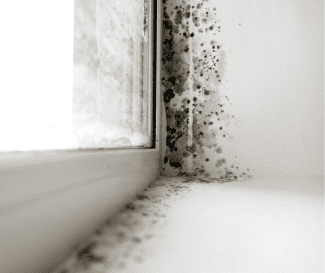 A common misconception about the labeled ‘black mold’ is that this type of mold is actually classified as a cluster of mold species and the most public of these black mold species is stachybotrys chartarum. These species of black mold absolutely thrive in warm, moist environments inside of a home – which can include baths, showers, toilets, kitchens, and basements where these two ideal conditions are met.
A common misconception about the labeled ‘black mold’ is that this type of mold is actually classified as a cluster of mold species and the most public of these black mold species is stachybotrys chartarum. These species of black mold absolutely thrive in warm, moist environments inside of a home – which can include baths, showers, toilets, kitchens, and basements where these two ideal conditions are met.
Toxic black mold gets its name and ominous perception based on the fact that this mold is a toxigenic, that releases toxins into the air that can be irritating and even harmful to public health – especially to those with preexisting conditions that can exacerbate their health issues. These toxins that are released from this mold species is called mycotoxins, which is produced as mold spores that’s sole mission is to eat, grow and form colonies of other spores inside of the infiltrated indoor environment. As these mycotoxins multiply in the area and reach high levels in the air, it can cause mold poisoning in those exposed to these in dramatically high levels of mycotoxins in their indoor environment.
Black Mold vs Regular Mold
The scary black mold can often be misidentified when trying to identify different species of mold that are growing inside of your home. Many household molds will form on the walls and surfaces in a variety of colors including green, white, grey, orange, red, green, and even black. Although you may recognize this black mold discoloration on your wall, this does not mean that this is the work of the toxic black mold.
When it comes to identifying a specific mold species that is growing inside of your home there are a few tell-tale signs to be on alert for including the texture of the mold and the particular health affects you experience when exposed to this mold indoors. Black mold vs mold, non-toxic household mold will usually only strike allergic-type symptoms in the body from exposure, whereas black mold can lead to the development of serious health issues including respiratory issues and even cancer after long-term exposure.
How Does Black Mold Form
The formation of mold inside of a household stems from one critical environmental condition that must be present in the environment, this condition is moisture. Moisture inside of a home whether it be from a leak, lack of proper ventilation, a flood, a humidifier, condensation, humid basements, and even irregular maintenance can be the culprit behind the formation of most household molds including black mold.
Mold enters into a home through the air in the form of spores that pass into the indoor air through people’s skin, clothing, shoes, bags, and from open windows and doors leading into the home. Once these mold spores come into the home, it will latch onto a surface and begin its growth process on the surface(s). The growth of mold including black mold will progress and eventually become airborne into the air exacerbating its growth in the enclosed space.
Identifying Black Mold
Are you concerned that mold could be growing inside of your home, but you aren’t aware of this aggressive fungus growth? It can be difficult to identify traces of mold inside of your home, other than the obvious signs like discoloration on the surfaces within the environment. No matter the type of mold, the same key identifiers will be present from the mold into the environment, which we must keep an eye out for inside our personal indoor environment.
These key identifying characteristics of black mold and other molds inside of a home will include the following clues:
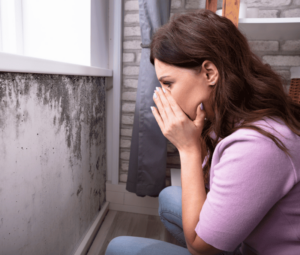 Distinctive Odor in the Air: Any type of mold growth indoors, especially black mold has a distinctive odor that is closely related to mildew or musty smells that flood the airspace of the environment. If you begin to detect this odor in the air, this can be a strong indicator of black mold growth in the home.
Distinctive Odor in the Air: Any type of mold growth indoors, especially black mold has a distinctive odor that is closely related to mildew or musty smells that flood the airspace of the environment. If you begin to detect this odor in the air, this can be a strong indicator of black mold growth in the home.- Noticeable Discoloration on Surfaces: Not surprisingly black mold is black, and therefore if you see a noticeable black spot present it can signify the growth of black mold within your personal environment.
- Surface Mold’s Texture: Black mold will take on a wet, slimy texture on the surfaces where it is growing. In comparison to other household molds, which typically contain a light, fuzzy texture to their appearance. This can be a key identifier when determining the specific mold form in the home.
- Survey Mold Prone Areas in the Home: Generally, mold grows in well-saturated areas that include basements, bathrooms, kitchens, and garages that are prone to water and will create the ideal conditions for black mold growth.
What Does Black Mold Look Like
The appearance of black mold is not always completely black, contrary to popular belief. This species of mold can also have prominent hues of green within its presence on the surfaces of a home. These hues of green within the appearance of black mold is usually a good indicator of a young mold colony that has just started developing within the indoor environment. Unlike a lot of household mold species, black mold is a slower growing mold that will take on the overall black appearance once the colony has reached maturity.
The blackish color of black mold is often times mistaken as dirt that has collected on the surfaces of a home, specifically dust or mud that has collected. Therefore, the mold is not always remediated upon first sighting of the mold presence on the walls and ceilings of the home.
What Does Black Mold Smell Like
As black mold begins to grow inside of the home, a smell will begin to emanate throughout the indoor environment rapidly. The smell produced from black mold can sometimes be one of the first indicators of mold growth inside of a home. Black mold smells similarly to that musty, putrid odor that is often associated with old homes. For homeowners that have experienced the growth of black mold within the walls of their home they will relate the odor to that of rotting wood or paper – sometimes even dirty wet socks. If you begin to experience an odor that anywhere closely resembles these odors, it will be ideal to have a mold remediation specialist come and inspect your home for potential intrusion of black mold within the indoor environment.
Is All Black Mold Dangerous?
Are you familiar with the name toxic black mold – a coined label for stachybotrys chartarum mold? Toxic black mold has been identified as toxic for quite a long time, and for many it is a scary species of mold that you wishfully hope never grows within your home. The dangers of this species of mold is in part to the toxins that they emit into the air called mycotoxins that can be significantly hazardous to human health upon exposure. These mycotoxins will attach to mold spores and travel throughout the air, and as these mold spores come into contact with occupants of the home, they will risk inhalation or ingestion of these dangerous mycotoxins/mold spores.
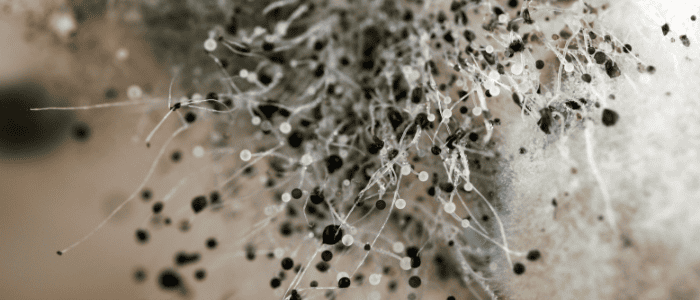
What are the Symptoms of Black Mold Making You Sick
Can mold make you sick? Black mold growth inside of a home can trigger and elicit certain health symptoms to those exposed to the mold. As we discussed earlier, the mycotoxins will have a significant impact on human health and trigger symptoms closely related to an upper respiratory tract infection. The health symptoms associated with black mold exposure can vary in severity depending on the standing health of those exposed to the mold such as those with a weakened immune system, those suffering from other health conditions, and children and the elderly with compromised immune systems.
The symptoms of black mold that are making you sick inside of your home includes the following health effects:
- Coughing
- Wheezing
- Stuffy nose
- Runny nose
- Red eyes
- Itchy skin or eyes
- Sore or itchy throat
- Nosebleeds
How to Get Rid of Black Mold in House
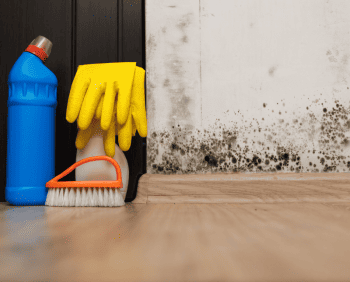 The all-encompassing process of eradicating mold completely from inside of your home can be a costly and time-consuming practice that is needed to restore the home back to normal, safe conditions. Ultimately, the removal of black mold from a home is a step-by-step process that will demand patience and the help of mold remediation specialists to thoroughly remove from the enclosed indoor environment.
The all-encompassing process of eradicating mold completely from inside of your home can be a costly and time-consuming practice that is needed to restore the home back to normal, safe conditions. Ultimately, the removal of black mold from a home is a step-by-step process that will demand patience and the help of mold remediation specialists to thoroughly remove from the enclosed indoor environment.
Moisture removal is the first step to getting rid of black mold inside of the home. Water intrusions and moisture are critical to the growth of black mold, and thus locating and removing any sources of moisture inside of the environment will help to remediate the growing mold situation, but this will not remove the mold. The area that the black mold is growing in within the home will need to be properly sealed off including doorways or any opening that leads to other areas of the home. If you enter into this contaminated environment where the black mold is present, it is important to wear a respiratory and other protective clothing to shield your health from being compromised due to the black mold spores and mycotoxins.
When it comes to removing the black mold from the surfaces of a home, a mold remediation specialist will be needed to accomplish this mold removal completely. Mold remediation specialists are trained professionals that work to extensively eradicate mold sources from the indoor environment and do so safely. Once a mold remediation specialist remediates the surfaces in your home, you can be sure that all mold sources were removed thoroughly from the surfaces of the home.
Air Filter Black Mold Remediation
Any species of mold, including black mold, will produce mold spores into the air that can circulate throughout the airspace and become challenging to remove from the air completely. Following a mold remediation within a home, the surfaces of the home will be completely exonerated from mold, however, the same cannot be said for the air in the enclosed indoor environment. It is important to treat the air of a home, following the remediation of mold inside of this space – as spores and even mycotoxins produced from black mold can be left lingering in the airspace.
The EnviroKlenz UV Air Purifier is an efficient air purifier that is able to effectively filter out mold spores traveling in the air, trapping it within a hospital-grade HEPA filter, and killing the collected mold spores through the use of UV-C lights above the HEPA filter inside the machine. EnviroKlenz utilizes an advanced earth mineral technology that works for toxic and noxious chemical and odor removal, that is integrated within an air filter inside of the air purifier, located above the UV-C lights and HEPA filter.
The hospital-grade HEPA filter is capable of trapping particulate matter larger than 0.3 microns with a 99.97 percent efficiency, this will include those small mold spores that travel in the air and get pulled into the air purifier and land on this HEPA filter. As the mold spores are collected on-top of the HEPA filter, the Ultraviolet Germicidal Rations (UV-C) lights will shine on the HEPA filter providing a high-efficiency of kill to the collected mold spores and other microorganisms found on the filter media.
EnviroKlenz UV Air Purifier Effectiveness Against Mold
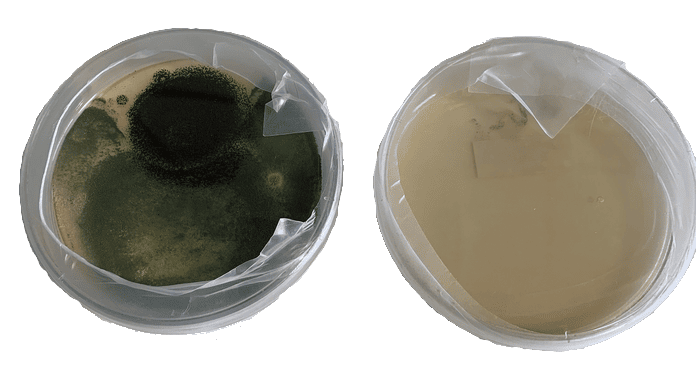
The following experiment was set up to illustrate the impact of the UVC light in the EnviroKlenz Air System. Two EnviroKlenz Air Systems were set up in the same indoor air environment with HEPA filters installed. HEPA filters are designed to capture a broad range of particulate mater 0.3 microns in size and larger.
In one system the UVC light bulbs were turned on, while in the other system UVC lights were not used. The systems were allowed to collect particulate matter for 1 week. After the week of collection ended, the systems were turned off and the HEPA surface was sampled with sterile collection swaps and streaked on to the nutrient agar plates (MEA). The plates were then allowed to incubate for 10 days.
In the image above, the plates are observed. The MEA plate on the left has mold growth. This was the sample collected from the system without the UVC lights running, while the sample on the right shows the UVC light being on killed the mold and the resulting plate with no growth observed.
UV Mobile Air System

✓ Patented earth mineral technology works to attack VOCs and break them down on a compound level
✓ No chemicals or masking agents
✓ Will not release any chemicals back into your environment
✓ UVC lamps are continuously shining on the collected organisms with high effeciency of kill and destruction
Comments
Post a Comment